
Plaridel
Scope & Guideline
Elevating Discourse in Communication Studies.
Introduction
Aims and Scopes
- Southeast Asian Media Studies:
Focuses on the unique media landscape of Southeast Asia, examining local practices, cultural products, and socio-political influences. - Representation and Identity:
Explores how various identities (gender, ethnicity, nationalism) are represented in media and communication, highlighting the implications of these portrayals. - Digital Communication and Social Media:
Investigates the effects of digital platforms on communication dynamics, including issues like misinformation, digital activism, and the influence of social media on public discourse. - Cultural Production and Consumption:
Analyzes the processes of creating and consuming cultural products, including cinema, television, and online content, with a focus on audience engagement and cultural significance. - Political Communication:
Examines the intersection of media and politics, including the role of media in shaping political narratives, public opinion, and civic engagement.
Trending and Emerging
- Fake News and Misinformation:
An increasing focus on the analysis of fake news, particularly in Southeast Asian contexts, highlights the urgency of addressing misinformation in digital communication and its societal impacts. - Gender and Sexuality in Media:
There is a growing interest in exploring gender representations and sexual identity in various media, indicating a trend towards understanding the complexities of gender politics and representation. - Impact of COVID-19 on Media Practices:
The pandemic has catalyzed numerous studies examining how media practices have adapted or transformed in response to global crises, including shifts in content creation and audience engagement. - Digital Activism and Social Movements:
Emerging themes around digital activism reflect the increasing role of social media in mobilizing communities and shaping public discourse on social issues. - Intercultural Communication:
Research exploring intercultural dynamics within media narratives is gaining traction, emphasizing the importance of understanding cultural exchanges in a globalized world.
Declining or Waning
- Traditional Media Analysis:
There has been a noticeable decrease in studies focusing exclusively on traditional media forms such as print journalism and legacy television, as newer forms of media gain traction. - Historical Contexts:
Research that delves deeply into historical analyses of media practices or representations seems to be waning, possibly overshadowed by contemporary issues and digital media studies. - Niche Cultural Studies:
Specific niche studies, particularly those that focus on less mainstream cultural phenomena, are becoming less frequent, indicating a potential shift towards broader themes that resonate with larger audiences.
Similar Journals
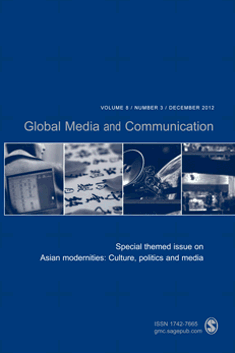
Global Media and Communication
Transforming Perspectives on Communication in a Digital AgeGlobal Media and Communication is a premier journal dedicated to advancing the fields of media and communication studies, published by SAGE Publications Ltd. With an ISSN of 1742-7665 and an E-ISSN of 1742-7673, this journal offers a platform for scholarly discourse and innovative research that explores the intricate relationships between global media practices and communication strategies. Recognized as a Q1 journal in both the Arts and Humanities (Miscellaneous) and Communication categories for 2023, it stands out in its commitment to delivering high-quality, peer-reviewed articles that contribute to the understanding of contemporary media landscapes. Located in London, United Kingdom, the journal benefits from being at the heart of cultural and digital innovation. Researchers, professionals, and students can look forward to insightful articles that not only critique existing frameworks but also propose new methodologies, ensuring that Global Media and Communication remains a vital resource for anyone interested in navigating the evolving dynamics of media and communication on a global scale.
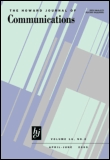
Howard Journal of Communications
Elevating discourse in communications with impactful research.The Howard Journal of Communications, published by Routledge Journals, Taylor & Francis Ltd, is a leading academic journal dedicated to advancing the field of communications. With a strong focus on both theoretical and practical elements, it has established itself as a vital resource for researchers, professionals, and students since its inception in 1988. The journal holds a prestigious Q2 ranking in the categories of Communication and Strategy and Management for 2023, positioning it among the top publications in these fields. The Scopus ranking also highlights its importance, with a notable rank of #158 in Social Sciences Communication and #268 in Business, Management and Accounting. Although the journal does not offer open access at this time, its comprehensive scope and commitment to quality scholarship ensure it remains an essential platform for disseminating innovative research and ideas in the rapidly evolving landscape of communication studies. Located in the United Kingdom, the journal continues to foster interdisciplinary dialogue and enhance academic discourse within these vital disciplines.
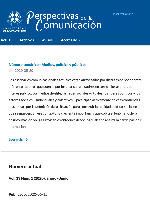
Perspectivas de la Comunicacion
Fostering Innovative Dialogue in Communication StudiesPerspectivas de la Comunicacion is an esteemed open-access academic journal published by UNIV FRONTERA, dedicated to the field of communication studies. With an ISSN of 0718-4867, the journal has established itself as a vital resource for scholars and practitioners since its inception in 2008, offering a platform for innovative research and discourse across various communication paradigms. Located in the heart of Chile at AV FRANCISCO SALAZAR, TEMUCO, this journal caters to a diverse international audience, encouraging contributions that reflect the global nature of communicative practices. While specific ranking metrics such as HIndex and Scopus Ranks are not readily available, the journal's open-access model ensures that its contributions are widely disseminated, promoting greater accessibility and engagement within the academic community. The objectives of Perspectivas de la Comunicacion include fostering critical discussion on contemporary issues in communication, highlighting interdisciplinary research, and providing a space for emerging voices in the field. This commitment to scholarly excellence positions the journal as a significant player in advancing knowledge and understanding within communication studies.

Fonseca-Journal of Communication
Empowering Voices through Rigorous Peer-Reviewed ScholarshipFonseca-Journal of Communication, published by EDICIONES UNIV SALAMANCA in Spain, serves as a vital platform for the dissemination of scholarly research in the fields of Communication, Linguistics, and Social Sciences. Since its transition to Open Access in 2010, this journal has ensured that innovative ideas and research findings are accessible to a global audience, fostering knowledge exchange among researchers, professionals, and students alike. With an impressive ranking in various categories—Q3 in Communication, Q2 in Linguistics and Language, and Q3 in Social Sciences—the journal reflects its commitment to excellence and relevance in contemporary academic discourse. Its Scopus rankings confirm its growing impact in the linguistic and social research spheres, making it a valuable resource for those seeking to advance their understanding and contribute to scholarship in these fields. Through its rigorous peer-review process and diverse content, Fonseca aims to stimulate critical conversations and inspire future research.

Media International Australia
Advancing Scholarly Dialogue in Media StudiesMedia International Australia is a leading journal that occupies a unique position at the intersection of communication and cultural studies. Published by SAGE Publications Ltd, this journal has established itself as a vital platform for scholarly discourse since its inception, now converging efforts from 2008 to 2024. With an impressive Q1 ranking in both the Communication and Cultural Studies categories, it ranks 12th out of 1304 in Cultural Studies and 42nd out of 511 in Communication, placing it within the 99th and 91st percentiles respectively according to Scopus metrics. The journal is committed to providing access to rigorous research that reflects contemporary issues in media, making it essential reading for researchers, professionals, and students keen on advancing their understanding of media's role in society. Despite not being fully Open Access, it ensures that quality research remains accessible through institutional subscriptions, allowing a broad audience to benefit from its insightful contributions.

Review of Communication Research
Elevating Research in Communication Theory and PracticeReview of Communication Research is a prestigious open-access journal dedicated to advancing the field of communication studies. Published by REVIEW COMMUNICATION RESEARCH from its base in Madrid, Spain, this journal has established itself as a vital platform for scholarly discourse since its inception. With an impressive impact factor and ranked in the Q1 quartile of communication journals for 2023, it holds a commendable position, placing it within the top 13% of approximately 511 journals in the communication category on Scopus. Since becoming open-access in 2013, the journal has enabled researchers, professionals, and students to access high-quality research without financial barriers, thereby fostering a greater dissemination of knowledge and dialogue within the community. Covering a wide array of topics from communication theory to media studies, the Review of Communication Research continues to contribute significantly to the understanding and evolution of communication in today’s interconnected world. Researchers are encouraged to engage with and submit their findings to this influential journal to further enrich the scholarly landscape.
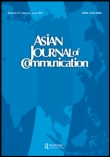
Asian Journal of Communication
Bridging Cultures Through Innovative ResearchThe Asian Journal of Communication, published by Routledge Journals, Taylor & Francis Ltd, is a premier scholarly platform dedicated to advancing the field of communication studies. Established in 1990 and continuing its impactful publication journey through 2024, this esteemed journal caters to a broad spectrum of interdisciplinary research, addressing critical issues in communication, media, and education in an Asian context. With an impressive impact factor and ranked in the top quartiles in both Communication (Q1) and Education (Q2), the journal is recognized for its rigorous peer-review process and its commitment to quality scholarship. Researchers, professionals, and students can access invaluable insights and innovative research trends, helping to bridge gaps and foster understanding across diverse communication practices. The journal is accessible through institutional subscriptions and promotes global discourse, making it an essential resource for anyone engaged in the vibrant field of communication.

Connectist-Istanbul University Journal of Communication Sciences
Bridging Disciplines, Enhancing UnderstandingConnectist-Istanbul University Journal of Communication Sciences is a distinguished academic publication under the auspices of Istanbul University, Faculty of Communication, dedicated to advancing the field of communication studies. Since its inception, this Open Access journal has facilitated the dissemination of groundbreaking research and innovative methodologies, particularly since it embraced an open access model in 2017, promoting wider accessibility and engagement. As a pivotal resource for researchers, practitioners, and students alike, Connectist fosters interdisciplinary dialogue, exploring contemporary issues in communication, media studies, and related disciplines. With a commitment to rigorous peer review and scholarly excellence, the journal serves as an essential platform for cutting-edge insights and developments in communication sciences, thereby contributing significantly to the academic community and beyond.
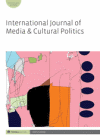
International Journal of Media & Cultural Politics
Unpacking the Dynamics of Cultural PoliticsThe International Journal of Media & Cultural Politics, published by INTELLECT LTD, serves as a vital platform for scholarly discourse in the rapidly evolving fields of communication and cultural studies. With an ISSN of 1740-8296 and an E-ISSN of 2040-0918, this journal has established itself as a key resource since its inception in 2009, with significant contributions from 2013 to 2023. It is categorized within the Q3 quartile for Communication and Q2 for Cultural Studies, reflecting its commitment to high-quality research and its influential role in shaping contemporary discourse, evidenced by its Scopus rankings of #322 in Cultural Studies and #289 in Communication. Although not an open access journal, its comprehensive access options and rigorously peer-reviewed articles make it an essential read for researchers, professionals, and students seeking to understand the intricate intersections of media, politics, and culture in today’s society, fostering a deeper engagement with critical issues in these domains.
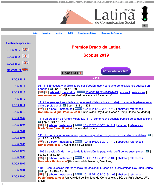
Revista Latina de Comunicacion Social
Empowering Voices in the Evolving Communication LandscapeRevista Latina de Comunicación Social is a prestigious and influential journal in the field of Communication, published by Historia Sistemas Informativos - HISIN. Established in 1998, this Open Access journal has continually contributed to the dissemination of high-quality research and innovative perspectives within the discipline. Based in Madrid, Spain, it has established itself as a vital platform for scholars, professionals, and students alike, particularly with its impressive ranking in the 2023 Scopus Ranks, where it sits at Rank #47 out of 511 journals in the Communication category, placing it in the 90th percentile. The journal embraces a broad scope that tracks the evolving trends and technologies in communication, with its Q1 status in Communication underlining its commitment to publishing impactful research. As it converges its years from 2011 to 2025, the journal remains dedicated to fostering academic discourse and engaging with emerging themes that shape the digital and traditional communication landscapes.